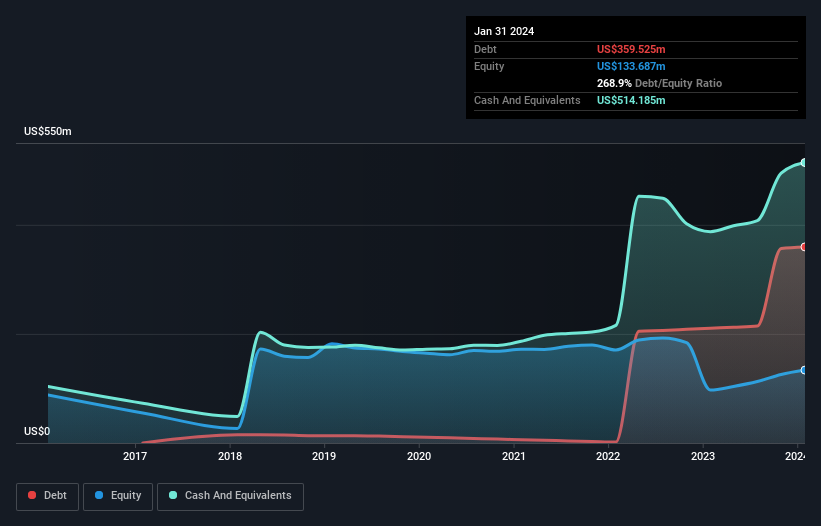Legendary fund manager Li Lu (who Charlie Munger backed) once said, 'The biggest investment risk is not the volatility of prices, but whether you will suffer a permanent loss of capital.' When we think about how risky a company is, we always like to look at its use of debt, since debt overload can lead to ruin. As with many other companies Zuora, Inc. (NYSE:ZUO) makes use of debt. But the more important question is: how much risk is that debt creating?
What Risk Does Debt Bring?
Debt is a tool to help businesses grow, but if a business is incapable of paying off its lenders, then it exists at their mercy. Ultimately, if the company can't fulfill its legal obligations to repay debt, shareholders could walk away with nothing. However, a more common (but still painful) scenario is that it has to raise new equity capital at a low price, thus permanently diluting shareholders. Of course, the upside of debt is that it often represents cheap capital, especially when it replaces dilution in a company with the ability to reinvest at high rates of return. The first step when considering a company's debt levels is to consider its cash and debt together.
View our latest analysis for Zuora
How Much Debt Does Zuora Carry?
As you can see below, at the end of January 2024, Zuora had US$359.5m of debt, up from US$210.4m a year ago. Click the image for more detail. However, its balance sheet shows it holds US$514.2m in cash, so it actually has US$154.7m net cash.

How Strong Is Zuora's Balance Sheet?
According to the last reported balance sheet, Zuora had liabilities of US$279.4m due within 12 months, and liabilities of US$410.7m due beyond 12 months. On the other hand, it had cash of US$514.2m and US$124.6m worth of receivables due within a year. So it has liabilities totalling US$51.4m more than its cash and near-term receivables, combined.
Since publicly traded Zuora shares are worth a total of US$1.32b, it seems unlikely that this level of liabilities would be a major threat. Having said that, it's clear that we should continue to monitor its balance sheet, lest it change for the worse. While it does have liabilities worth noting, Zuora also has more cash than debt, so we're pretty confident it can manage its debt safely. There's no doubt that we learn most about debt from the balance sheet. But ultimately the future profitability of the business will decide if Zuora can strengthen its balance sheet over time. So if you're focused on the future you can check out this free report showing analyst profit forecasts.
Over 12 months, Zuora reported revenue of US$432m, which is a gain of 9.0%, although it did not report any earnings before interest and tax. We usually like to see faster growth from unprofitable companies, but each to their own.
So How Risky Is Zuora?
We have no doubt that loss making companies are, in general, riskier than profitable ones. And the fact is that over the last twelve months Zuora lost money at the earnings before interest and tax (EBIT) line. And over the same period it saw negative free cash outflow of US$29m and booked a US$68m accounting loss. But the saving grace is the US$154.7m on the balance sheet. That means it could keep spending at its current rate for more than two years. Overall, we'd say the stock is a bit risky, and we're usually very cautious until we see positive free cash flow. When analysing debt levels, the balance sheet is the obvious place to start. However, not all investment risk resides within the balance sheet - far from it. To that end, you should be aware of the 3 warning signs we've spotted with Zuora .
Of course, if you're the type of investor who prefers buying stocks without the burden of debt, then don't hesitate to discover our exclusive list of net cash growth stocks, today.
Valuation is complex, but we're here to simplify it.
Discover if Zuora might be undervalued or overvalued with our detailed analysis, featuring fair value estimates, potential risks, dividends, insider trades, and its financial condition.
Access Free AnalysisHave feedback on this article? Concerned about the content? Get in touch with us directly. Alternatively, email editorial-team (at) simplywallst.com.
This article by Simply Wall St is general in nature. We provide commentary based on historical data and analyst forecasts only using an unbiased methodology and our articles are not intended to be financial advice. It does not constitute a recommendation to buy or sell any stock, and does not take account of your objectives, or your financial situation. We aim to bring you long-term focused analysis driven by fundamental data. Note that our analysis may not factor in the latest price-sensitive company announcements or qualitative material. Simply Wall St has no position in any stocks mentioned.
About NYSE:ZUO
Zuora
Provides a monetization suite for modern businesses to help companies launch and scale new services and operate dynamic customer-centric business models in the United States and Japan.
Excellent balance sheet and good value.
Similar Companies
Market Insights
Community Narratives



